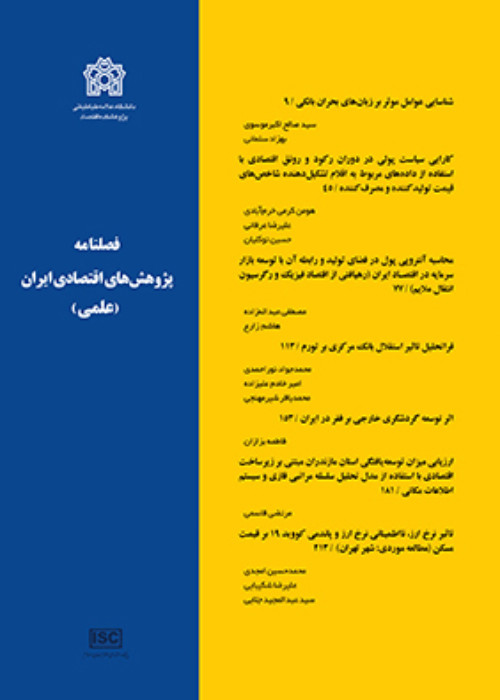Determining the Upstream Premium Based on Exploration and Development Risk Model: A Monetary VaR Approach
Author(s):
Article Type:
Research/Original Article (دارای رتبه معتبر)
Abstract:
A review of empirical studies in the field of insurance of upstream oil and gas projects suggests that domestic insurance companies and insurance consortiums in Iran rely on the experience of reinsurance companies to determine premiums and risk conditions. Given the economic sanctions and restrictions on determining precise premiums and conditions for direct insurance and reinsurance of oil assets, it is necessary to establish a method to determine premiums even under normal circumstances that can be referred to international reinsurers. To address this need, the present study adopted an empirical method that uses risk-based valuation and the monetary value at risk (VaR), which covers a wide range of relevant oil and energy insurance aspects. The results showed that the research method can determine the premium of oil assets following international standards, taking into account expert opinions and other domestic considerations.IntroductionOil and gas continue to be among the primary sources of energy globally, hence a crucial and fundamental part of the world economy. The various sectors within this vast field offer significant capacities and resources at a large scale, including research, equipment, and resources for exploration, development, and utilization, as well as the derivatives in the real sector processes. In addition, transportation, exchanges, transactions, physical markets, and stock exchanges also play a significant role in this industry. The world economy is thus highly dependent, both directly and indirectly, on the oil and gas industry. It is evident that the global oil and gas industry involves a vast amount of capital and risk, which is more complex and extensive than one may imagine. The industry interacts with numerous sectors of the economy, with extensive links that exceed beyond a single field. Considering the relatively small share of oil and energy insurance in the portfolio of the insurance industry, there are various factors that prevent the entry of insurance services into this area on a significant scale. One significant obstacle is the lack of scientific studies on determining the value at risk for oil assets, which is a crucial factor in determining the volume and size of insurance premiums for insurable oil and gas assets. Using the valuation and estimation of monetary VaR of oil assets, the present study aimed to develop a method for insurance companies to determine the insurance premium of oil and gas assets. An example was provided to demonstrate the applicability of the proposed method in practice. Materials and MethodsTo conduct a risk-based valuation, the study employed Smith’s method as well as the method proposed by Knapp and Heij in order to estimate the value at risk for oil assets.The NPV for the valuation model of exploration and development risk will be as follows (Smith, 2004): (1)Where CF0 is the drilling cost, is the probability of a failed well and {CF1, CF2... CFr} are the expected cash flows in case of success of the well and (i) is the discount rate.According to Knapp and Heij (2017), identifying risk factors, which are variables that pose a risk for an oil asset, is crucial in estimating the value at risk. The risk factors are evaluated based on their probability of occurrence.The monetary VaR is estimated based on the insurable value of a physical asset, which is typically the replacement cost or the actual cash value of the asset covered by standard insurance policies.To estimate the value at risk, two probabilities are combined, which are determined based on the total insurable value (TIV). For instance, if there are five risk groups denoted as j (j=1,...,5), vj represents the sum of the insurable value for each type. TIV is defined as the total of all five groups, as follows: Furthermore, Pinc represents the probability of an event occurring within a year. Pj is the conditional probability of damage in group j occurring in relation to a particular event. Then monetary VaR is then defined as follows: (2)It is important to note that TIV is derived from the method proposed by Smith (2004), which can be used to assess the value of the entire property or its individual parts and components.The insurance rate and premium can be estimated on the basis of the model of exploration and development risk, along with the future discount rate. This estimation includes the initial cost (drilling or installation cost) CF0 and is given by the following equation:NPV, in Relation (1), is replaced by the future value (FV) or the total insurable value (TIV) of the oil asset.CFt = CF0: NPV is equivalent to book value or price determined by official experts or official pricing authorities.PDH: Probability of occurrence of major risks, which is considered equivalent to catastrophic risks leading to total damage.i: It represents risk insurance premium, which is equivalent to the probability of the occurrence of conventional risks that each oil asset faces according to its specific conditions.Now Relation (1) will be changed to Relation (3): (3)Now monetary VaR is calculated as follows: (4)In equation (4), V is TIV, which is equivalent to FV calculated based on Relation (2).Results and DiscussionThe study used the information on the insurance policy of HP-2000 drilling rig of North Drilling Company. Table 1 Information on the HP-2000 drilling rigThe value of the drilling rigReinsurance premium rateMarket premium rateInsurance premium12000.0040.00283.4(billion rials) (million rials)* Source: issued insurance policyThe future value of the drilling rig for one year is described in the following table:Table 2 The future value of the drilling rigNPV iFV12000.00220.0032400(billion rials) (billion rials)* Source: research resultsThe monetary VaR based on the future value at risk (FV), which is equivalent TIV, for the insured drilling rig is as follows according to Relation (2):Table 3 The monetary VaR of the drilling rigFV=TIV MVR24000.00220.84.3(billion rials) (million rials)* Source: research resultCatastrophe risk (Pinc) and the 5-fold decomposed risks of the oil rig are determined based on expert opinion, which will be the basis of monetary VaR estimation.The premium values and the rate calculated based on the monetary VaR were compared to the premium values in both cases of reinsurance and market (Table 4). Premium rate is obtained by dividing premium, which in the proposed methods is equal to Monetary VaR (MVR), by oil rig price.Table 4 Comparison of the insurance premium rate based on the MVR method with the reinsurance and market rateMVR rateReinsurance rateMarket rate0.00350.0040.0028* Source: research resultsConclusionThe present study highlighted the characteristics and significance of the oil, gas, and petrochemical industry within the global economy, emphasizing the extensive interactions of this industry with various sectors of the economy, particularly in the field of insurance.The study used a distinctively innovative methodology which combines Smith’s (2004) risk valuation of oil assets with Knapp and Heij’s (2012; 2017) monetary VaR approach to determine the insurance premium rate. The proposed research method allows for the determination of an insurance premium rate that is equivalent to international reinsurance rates, based on the factual, environmental, and market conditions. The study offers insurance and oil engineering experts the possibility of calculating an appropriate insurance premium rate for an oil project based on the identified risks using empirical and technical knowledge, as considered in the proposed method.
Keywords:
Language:
Persian
Published:
Iranian Journal of Economic Research, Volume:28 Issue: 95, 2023
Pages:
41 to 80
magiran.com/p2631392
دانلود و مطالعه متن این مقاله با یکی از روشهای زیر امکان پذیر است:
اشتراک شخصی
با عضویت و پرداخت آنلاین حق اشتراک یکساله به مبلغ 1,390,000ريال میتوانید 70 عنوان مطلب دانلود کنید!
اشتراک سازمانی
به کتابخانه دانشگاه یا محل کار خود پیشنهاد کنید تا اشتراک سازمانی این پایگاه را برای دسترسی نامحدود همه کاربران به متن مطالب تهیه نمایند!
توجه!
- حق عضویت دریافتی صرف حمایت از نشریات عضو و نگهداری، تکمیل و توسعه مگیران میشود.
- پرداخت حق اشتراک و دانلود مقالات اجازه بازنشر آن در سایر رسانههای چاپی و دیجیتال را به کاربر نمیدهد.
In order to view content subscription is required
Personal subscription
Subscribe magiran.com for 70 € euros via PayPal and download 70 articles during a year.
Organization subscription
Please contact us to subscribe your university or library for unlimited access!



